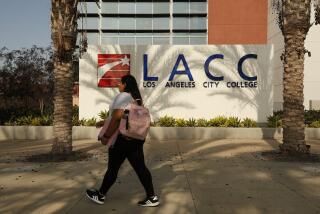Obama plan would make community colleges nearly free for millions

Aiming to dramatically expand access to higher education, President Obama on Thursday proposed making community college virtually free for millions of high school graduates — a potential boon for California’s system, the largest in the nation.
The federal government would pay 75% of the costs of community college, requiring states to pick up the rest, under the proposal that White House officials said would be included in the 2016 federal budget and require congressional approval.
“What I’d like to do is to see the first two years of community college free for everybody who is willing to work for it,” Obama said in a video filmed on Air Force One and posted on Facebook on Thursday. The video came ahead of the president’s planned visit Friday to a community college and technical center in Knoxville, Tenn., as part of a trip designed to preview his policy plans for 2015.
California officials said they would be thrilled with new federal dollars to help the state’s two-year community college system recover from the lingering effects of the 2008 recession. The system enrolls 2.1 million students on 112 campuses.
“Our first reaction is that we are very excited about the president’s plan to provide more opportunities for students to attend community colleges,” said Brice W. Harris, California Community Colleges chancellor, in a statement. “Community colleges are the primary access point to higher education in California and the nation, and our economy is increasingly requiring college-educated workers. We look forward to working with the White House as the proposal takes shape.”
Officials said the system could accommodate an influx of more students, since so many were turned away amid severe budget cuts during the recession. Between 2007 and 2012, the system lost $1.5 billion in funding, a quarter of course offerings and nearly 500,000 students.
An infusion of voter-approved tax dollars and a rebounding economy have improved the picture somewhat. Last year, the system was able to offer 23,000 more courses and enroll more than 15,000 more students over the previous year, said Paul Feist, a spokesman for the community colleges.
“We think the demand is there,” he said.
At $46 per unit, California community college fees are the lowest in the nation, and more than 40% of students receive state fee waivers.
Francisco Rodriguez, chancellor of the Los Angeles Community College District, said Obama’s proposal could return California to the days when greater public funding made these campuses essentially free to students.
“From the standpoint of building a middle-skills workforce, this plan would provide more access and more opportunity,” Rodriguez said. “It’s a bold statement.”
Rodriguez said he believes that if state lawmakers adopt the president’s proposal, the district’s enrollment would grow by up to 15%. L.A.’s nine colleges serve about 200,000 students annually.
It’s unclear if the funding would alleviate overcrowding in some courses. Many students still complain that they have a difficult time enrolling in such high-demand classes as introductory math and English.
Nearly 75% of California community college students need to take those courses before they can take classes for credit, according to state statistics. Community college leaders recently launched an initiative to ensure that about 250,000 additional students complete their two-year degrees, or transfer, by decreasing the amount of time they spend taking remedial courses. But they said they weren’t counting on a large increase in state funding to reach those goals.
About half the students enrolled in California’s community colleges take more than four years to graduate, according to a recent study. Among full-time students who entered a community college in 2007, more than 35,000 had not earned their degrees within three years and most were no longer enrolled in college, according to a 2012 study.
The community college proposal echoes one of Obama’s favorite themes: empowering the middle class through education and opportunity. He sees the decline in state funding for higher education as a major barrier to those aspiring to the middle class.
White House advisors declined to say how much the proposal would cost or how the administration planned to pay for it, although experts say such a venture could cost the federal government tens of billions of dollars.
To qualify, students would have to attend college at least half-time and maintain a 2.5 grade-point average. States would be required to maintain their current levels of community college funding. And colleges would have to offer academic programs that would fully transfer to four-year institutions or vocational programs with high graduation rates that offer training in demand in the job market.
The White House estimated the plan would save the average community college student $3,800 annually.
Obama’s plan was inspired by programs in Chicago and Tennessee that guarantee free tuition to all high school seniors who attend a community or technical college. Launched in 2008, the Tennessee program has awarded a total of $14 million in private donations to help about half the state’s seniors attend any of the state’s 27 colleges of applied technology, community colleges or four-year public universities offering an associate’s degree. The scholarships make up any shortfall left from federal and state aid for the $4,000 annual college tuition.
This year, Tennessee Gov. Bill Haslam expanded the program statewide and committed state lottery dollars for the scholarships. So far, nearly 58,000 of the state’s 71,000 high school seniors have applied for the scholarships for college beginning next fall, according to Krissy DeAlejandro, executive director of the Tennessee program.
She added that more African Americans and Latinos have applied to the program than currently attend two-year colleges. The program also targets students who would be the first in their families to attend college.
The three-year graduation rate under the program is 33% — not as high as program backers desire but three times the state rate, DeAlejandro said.
Some analysts and educators expressed concerns that the president’s proposal could face trouble in the Republican Congress. White House domestic policy chief Cecilia Munoz, however, noted that Tennessee’s program is in place under a Republican governor and said the effort has “bipartisan appeal.”
So far, Obama’s efforts to bring down the cost of college have been meager. He has tried to tie financial aid to college performance and urged states to take performance into consideration when distributing funds to their public colleges. The president also has raised by $1,000 the maximum Pell Grant award for working- and middle-class families and changed the student loan system to cut out subsidies to banks providing college loans.
In California, Robert Shireman, executive director of the nonprofit California Competes, said if the federal government pays three-quarters of the tuition, the state could potentially use the extra money for other community college purposes.
“That would give community colleges more resources, more seats and more students and more ways to support them better,” he said.
More to Read
Sign up for Essential California
The most important California stories and recommendations in your inbox every morning.
You may occasionally receive promotional content from the Los Angeles Times.









